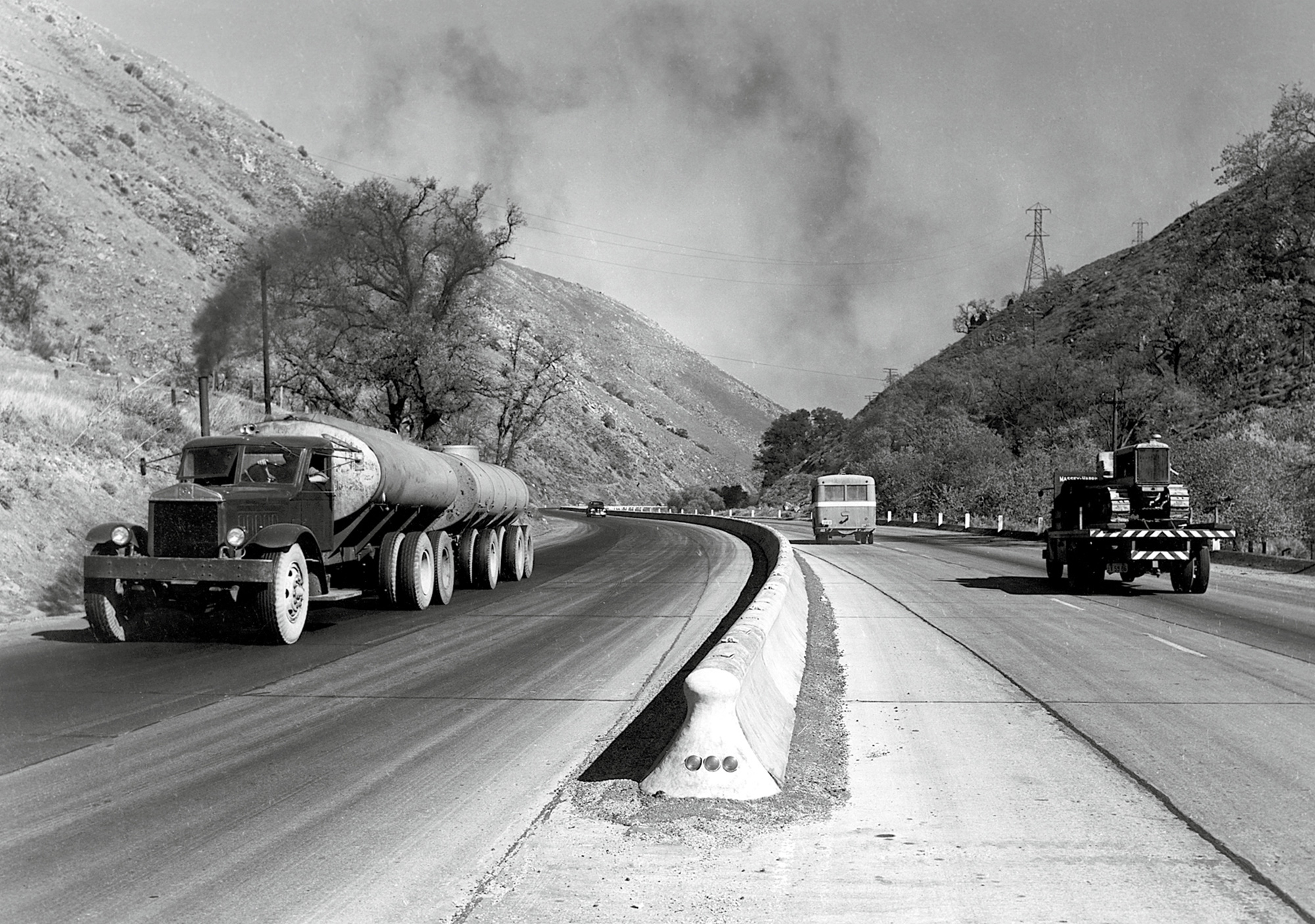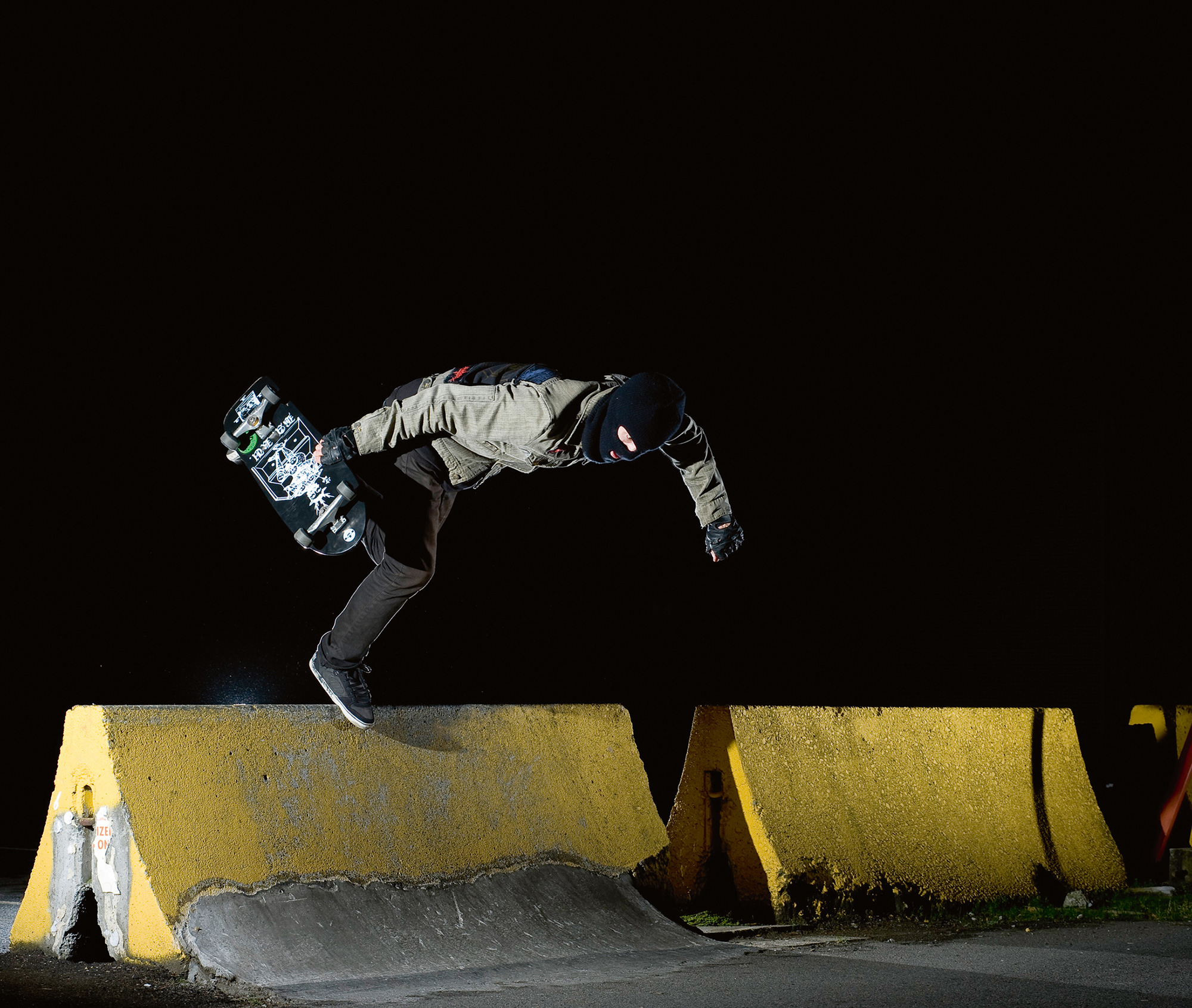Barrier Is Everywhere
Block and yaw
Jocko Weyland

They are found on endless miles of American highways, in war zones, and in the breaches of compromised floodwalls surrounding New Orleans, among other places. Twelve-and-a-half feet long and thirty-two inches high, they are known by many names—Pennsylvania Separators, traffic dividers, or K-rails—and their kin include the F barrier, the Texas Barrier, the Alaska Barrier, the “T” and “L” barriers, the Ontario Tall Wall, and the water-filled orange plastic barrier. But the classic is the venerable Jersey barrier.
Standardized, never deviating from that wedge form, almost always white, and not too exciting to look at, these ubiquitous roadside “attractions” are associated with the state of New Jersey despite the fact that they were actually first developed in California for use on the Grapevine Grade, with its infamous “Deadman’s Curve,” on the Ridge Route highway linking Los Angeles and the San Joaquin Valley. Consisting of a 4,000-foot elevation change and a curving six-percent mountain descent full of treacherous grades, the road was initially outfitted with wood-beam guardrails on steel posts to separate lanes. But these were damaged by truckers brushing their vehicles against them to supplement braking on downhill runs; moreover, they couldn’t stop vehicles that struck them at wide angles and breached the rail, and the Grapevine Grade continued to have a higher than average incidence of fatal head-on collisions. In 1946, the California Division of Highways removed the guardrails and installed parabolic concrete median barriers in twenty-six-inch-high, twenty-eight-inch-wide, ten-foot-long sections weighing three thousand pounds each. These immediately proved to be successful in deterring truckers from using them for braking and also in preventing collisions, garnering positive notices the following year in the construction industry bible, the Engineering News-Record.
In 1949, New Jersey installed concrete median barriers on US Route 22 in the state’s rural Hunterdon County. State Highway Department engineers came up with a nineteen-inch-high, thirty-inch-wide curb with concave parabolic faces on each side. They also added another feature that proved important; a two-inch-thick outer layer of white concrete that was much more reflective than standard grey cement and thus more visible at night. The barriers reduced the number of head-on collisions from fifteen in 1955 alone to only one over the following three-and-a-half years; injuries fell by seventy-five percent. Barriers had proven their usefulness, and over the next few years they were installed on seventy-five additional miles of highway. By 1959, a standard height of thirty-two inches with a twenty-four-inch-wide base was settled upon. These refinements in size and color, as well as the barriers’ widespread deployment, have bestowed upon New Jersey the honor of being forever linked to these workhorse slabs.
Median barriers weren’t an unqualified success (highway officials observed that while barriers reduced fatalities, they also seemed to increase the number of accidents and injuries), but fatal cross-over collisions continued to increase on roads that didn’t have them. After the state of California conducted numerous tests between 1965 and 1968 by crashing radio-controlled cars at various speeds and approach angles, researchers concluded that the New Jersey concrete median barrier was an effective, low-maintenance design. By 1975, nineteen states had adopted the Jersey barrier, lining more than one thousand miles of US highway. The genius of the barriers and their function is that, unbeknownst to most motorists, not only do they separate opposing flows of traffic, they also minimize the severity of accidents by allowing the driver to regain control of their vehicle after impact. During a sideswipe, the barrier lets the front tire ride up its lower angled face, redirecting the car and getting it back on the roadway with minimal damage.[1]
The barriers’ connection to death and safety goes further than the highway. In another guise they have become indispensible, along with Alaska and Texas barriers, in war zones like Iraq and Afghanistan to make “offsets” to protect buildings against bomb-laden vehicles. Used to create serpentine approaches at checkpoints, forcing cars into complex maneuvers that reduce speeds, they are also prevalent at government buildings across the United States. And they have inspired more far-flung reuse ideas as well, like architect Mark Oberholzer’s as yet unrealized notion to integrate double-stacked Darrieus turbines into barriers that would harness wind generated by passing cars.

But the most successful and rampant reconfiguration of the Jersey barrier involves another life that the anonymous engineers who devised it never could have imagined. Like sidewalks, backyard swimming pools, ledges, benches, and many other man-made forms, the Jersey barrier has been repurposed as a found-object plaything by skateboarders. Since at least the early 1980s, skateboarders have been rolling up onto barriers, often with the help of an illegally poured skater-built concrete transition connecting the roadway and the barrier. Tricks first developed in pools and ramps are now performed on barriers (as are all manner of street-oriented moves), and no skateboard magazine or video is considered complete without some barrier riding. They have even inspired fanatical groups like Vancouver’s Barrier Kult, a shadowy movement exclusively devoted to riding barriers, usually at night while wearing balaclavas. According to a 2008 Federal Highway Administration report on the efficacy of the concrete barrier, “vehicle roll, pitch, and yaw angular displacements were deemed acceptable, because they did not adversely influence occupant risk safety criteria nor cause rollover.” Roll, pitch, and yaw were also on the mind of the author of the Barrier Kult manifesto, “the mysterious Deer Man of Dark Woods,” who, channeling and transmuting the government’s bureaucratic language into the delirious cadences of skateboard argot, called the barrier “the utmost form of the common tight quarter pipe that eventually represented to us a form of truth, self and skateboard weapon fulfillment,” claiming “barrier is everywhere and is always ready for plague and bone-scraping rituals.”
The author would like to thank Kelly Giblin for his gracious help in preparing this article.
- Some of the information presented here is included in Kelly Giblin’s definitive article “The Jersey Barrier,” Invention and Technology, vol. 22, no. 1 (Summer 2006).
Jocko Weyland is the author of The Answer is Never: A Skateboarder’s History of the World (Grove Press, 2002) and has written for Thrasher, the New York Times, Apartmento, and other publications. He is the creator of Elk magazine, books, and gallery, and a contributing editor for Open City magazine. Recent exhibitions include “Les Souvenirs Sont Cors de Chasse” at Starcow in Paris and a two-person show with MK Guth at New York’s Franklin Parrasch Gallery in April 2010.